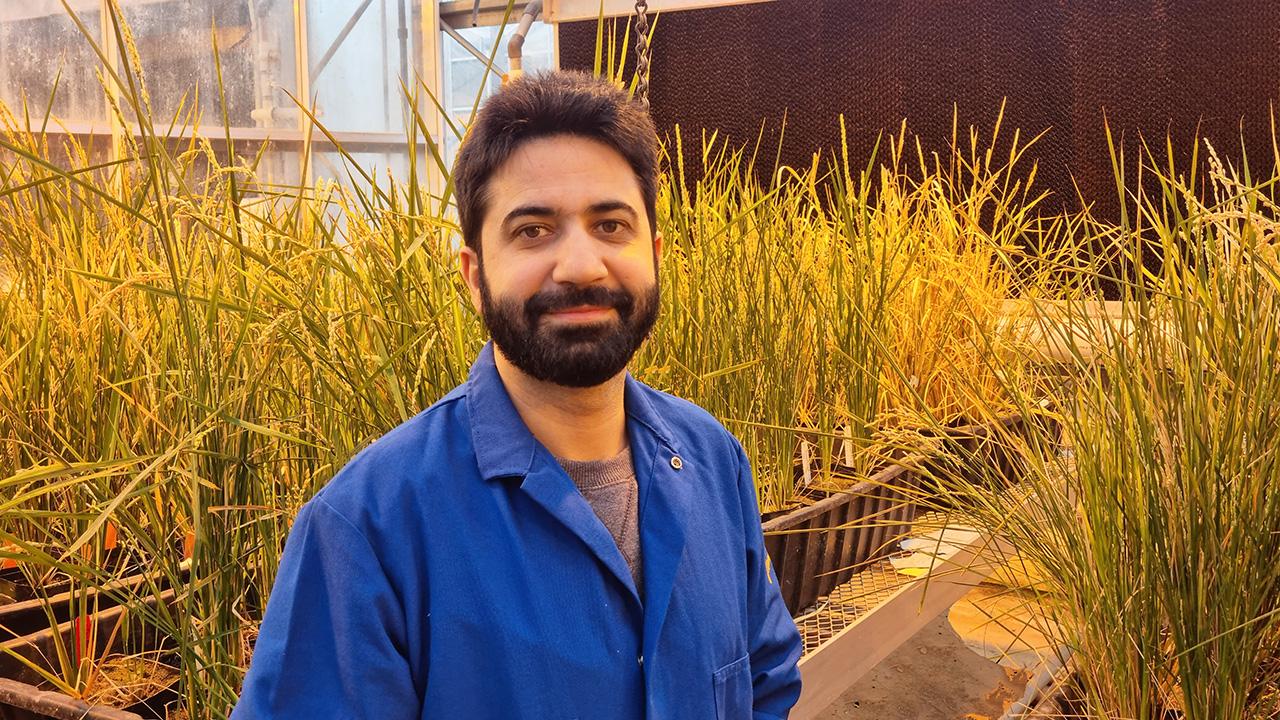
Khanday and team pioneer rice hybridization method
Breeding breakthrough could feed billions
Quick Summary
- Imtiyaz Khanday and an international team developed a method to propagate hybrid rice seeds with 95% efficiency, allowing for cheaper and sustainable rice production. This breakthrough could help provide high-yield, disease-resistant rice for low-income f
Imtiyaz Khanday, an assistant professor in the UC Davis Department of Plant Sciences, is co-leading an international team that has propagated a commercial hybrid rice strain as a clone through seeds with 95 percent efficiency. The method that led to this breakthrough could lower the cost of hybrid rice seed, making high-yielding, disease-resistant rice strains available to low-income farmers worldwide. The work was published Dec. 27 in Nature Communications.
Their new genetic method solves a long-standing problem for seed breeders and farmers: First-generation hybrids of crop plants often show higher performance than their parent strains, a phenomenon called hybrid vigor. But this does not persist if the hybrids are bred together for a second generation. So, when farmers want to use high-performing hybrid plant varieties, they need to buy new seed each season.

That cost is an enormous burden to small farmers in developing countries.
Rice, the staple crop for half the world’s population, is relatively costly to breed as a hybrid for a yield improvement of about 10 percent. This means that the benefits of rice hybrids have yet to reach many of the world’s farmers, said Gurdev Khush, adjunct professor emeritus in the Department of Plant Sciences. Working at the International Rice Research Institute from 1967 until retiring to UC Davis in 2002, Khush led efforts to create new high-yield rice varieties, work for which he received the World Food Prize in 1996.
One solution to this would be to propagate hybrids as clones that would remain identical from generation to generation without further breeding. Many wild plants can produce seeds that are clones of themselves, a process called apomixis.
“Once you have the hybrid, if you can induce apomixis, then you can plant it every year,” Khush said.
However, transferring apomixis to a major crop plant has proven difficult.
One Step to Cloned Hybrid Seeds
In 2019, Khanday and Venkatesan Sundaresan, of the UC Davis Department of Plant Biology, achieved apomixis in rice plants, with about 30 percent of seeds being clones.
Now, Khanday, Sundaresan and colleagues in France, Germany and Ghana have achieved a clonal efficiency of 95 percent, using a commercial hybrid rice strain. They have also shown that the process could be sustained for at least three generations.
The single-step process involves modifying three genes called MiMe which cause the plant to switch from meioisis, the process that plants use to form egg cells, to mitosis, in which a cell divides into two copies of itself. Another gene modification induces apomixis. The result is a seed that can grow into a plant genetically identical to its parent.
The method would allow seed companies to produce hybrid seeds more rapidly and at larger scale, as well as providing seed that farmers could save and replant from season to season, Khush said.
“Apomixis in crop plants has been the target of worldwide research for over 30 years, because it can make hybrid seed production accessible to everyone,” Sundaresan said. “The resulting increase in yields can help meet global needs of an increasing population without having to increase use of land, water and fertilizers to unsustainable levels.”
The results could be applied to other food crops, Sundaresan said. In particular, rice is a genetic model for cereal crops including maize and wheat, which with rice constitute major food staples for the world.
Decades of research
Khush recalled that he organized a 1994 conference on apomixis in rice breeding. When he returned to UC Davis in 2002, he gave a copy of the conference proceedings to Sundaresan.
“It’s been a long project,” he said.
Coauthors on the paper are: Aurore Vernet, Donaldo Meynard, Delphine Meulet, Olivier Gibert, Ronan Rivallan, Anne Cecilé Meunier, Julien Frouin, James Tallebois, Daphné Autran, Olivier Leblanc and Emmanuel Guiderdoni, CIRAD and University of Montpellier, France; Qichao Lian and Raphael Mercier, Max Planck Institute for Plant Breeding Research, Cologne, Germany; Matilda Bissah, CSIR Plant Genetics Resources Research Institute, Ghana; and Kyle Shankle, UC Davis. Khush is not an author on the new paper.
The work was supported in part by funding from the Innovative Genomics Institute and the France-Berkeley Fund.
Media Resources
Read the paper (Nature Communications)
Media Contacts
- Gurdev Khush, Plant Sciences, gurdev@khush.org
- Venkatesan Sundaresan, Plant Biology, sundar@ucdavis.edu
- Andy Fell, News and Media Relations, 530-304-8888, ahfell@ucdavis.edu
- Trina Kleist, Department of Plant Sciences, (530) 601-6846, tkleist@ucdavis.edu
To see more UC Davis news, visit our online newsroom: https://www.ucdavis.edu/news.
